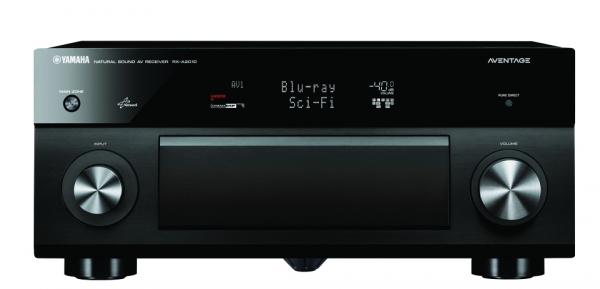Review: Yamaha Aventage RX-A2010 A/V Receiver

The company that makes most everything (and makes most everything it makes pretty damned well), Yamaha has been tuning up its forks, and the result seems to be ever more feature-packed, value-focused designs.
Take A/V receivers. Yamaha's new RX-A2010, in its Aventage receiver line, seems very similar to the RX-A3000 we examined just over a year ago. It offers the same power (140 watts in 2-channel mode), nearly identical feature sets, and near-doppelganger cosmetics.
A couple distinctions are worth mentioning, however. The new model packs in 9 amplifier channels, compared with the earlier unit's 7. It has an improved graphical interface with more info on tap, and a few more streaming and Web-powered features. And - oh, yeah - the RX-A2010 costs some $300 less.
Setup
As is usually the case these days, my initial setup involved nothing more demanding than plugging in HDMI cables and connecting speaker wires. Lots of speaker wires: The Yamaha facilitates the use of both front-height (Front Presence) and back-surround channels. I included the former in my setup, using the neutral pair of small-bookshelf two-ways that I keep around for just such duty. There are myriad amp-assign options for the receiver's nine power-amp channels, including biamping the main fronts, the aforementioned auxiliary frontal channels, and options for not one but two multiroom stereo zones. Suffice it to say, the speaker-connection section of the PDF owner's manual (no printed book is included - a sign o' the times) runs to some 11 pages.
Yamaha's proprietary auto-setup routine, the impressively named YPAO (Yamaha Parametric room Acoustic Optimizer) works like most such systems: You plug in the supplied measurement mike, hit the onscreen start icon, and get out of the way while robotic sweeps and noise bursts let the receiver identify speaker locations and bandwidths. This worked very accurately in terms of distance and level, and it selected the perfectly appropriate crossovers to all channels.
YPAO delivers three choices for its corrective equalization: "normalize" all channels' response to the fronts, set all channels to an idealized "flat response," or shape all channels via a mode dubbed "Natural." This last, which I judged to be a very mildly down-tilted target curve, was my favorite. That said, as always I did all my qualitative listening with YPAO's EQ feature (but not the other setup calibrations) defeated.





























































